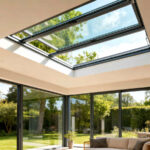
Victorian Greenhouse Living: Blending Elegance and Nature in Modern Life
Victorian greenhouse living offers a unique blend of elegance and nature, seamlessly integrating the charm of a Victorian greenhouse into modern life. A Victorian glass greenhouse, with its ornate ironwork and expansive windows, creates a serene retreat filled with natural light and lush greenery. Whether used as a greenhouse Victorian-style garden, a cozy reading nook, or a space for entertaining, it enhances well-being by connecting you to nature. This timeless design not only adds architectural beauty to your home but also promotes relaxation, mindfulness, and a sustainable lifestyle, making it a perfect fusion of history and contemporary living.

The Victorian greenhouse, with its intricate ironwork, arched windows, and timeless charm, is more than just a gardening space—it’s a lifestyle choice that seamlessly blends elegance and nature. A Victorian glass greenhouse, in particular, offers a unique opportunity to bring the beauty of the outdoors into your daily life while adding a touch of historical sophistication to your home. Whether you’re a plant enthusiast, a lover of architecture, or someone seeking a tranquil retreat, greenhouse Victorian living can transform your relationship with nature and elevate your modern lifestyle. Let’s explore how this iconic structure can become a central part of your home and life.
1. The Timeless Appeal of a Victorian Greenhouse
The Victorian greenhouse is a symbol of elegance and innovation, dating back to the 19th century when greenhouses became a status symbol among the wealthy. These structures were designed to showcase exotic plants and provide a space for leisurely pursuits, combining functionality with aesthetic beauty. Today, a Victorian greenhouse continues to captivate with its ornate design, featuring intricate details, curved roofs, and expansive glass panels that flood the space with natural light.
Incorporating a Victorian greenhouse into your property not only adds architectural interest but also creates a connection to a bygone era. Its classic design complements both traditional and modern homes, making it a versatile addition to any setting. Whether you use it as a garden room, a relaxation space, or a place to entertain, a Victorian greenhouse brings a sense of timeless charm to your life.
2. The Victorian Glass Greenhouse: A Sanctuary of Light and Greenery
A Victorian glass greenhouse is a masterpiece of design, offering a seamless connection between the indoors and outdoors. The transparency of the glass allows you to enjoy the beauty of your garden year-round, regardless of the weather. This flood of natural light has numerous benefits for mental and physical well-being, including improved mood, better sleep, and reduced stress.
Inside a Victorian glass greenhouse, you can create a lush oasis filled with plants, flowers, and even small trees. The abundance of light and controlled environment makes it ideal for growing a wide variety of species, from tropical plants to seasonal blooms. This connection to nature fosters a sense of calm and mindfulness, providing a peaceful escape from the demands of modern life.
3. Greenhouse Victorian Living: A Modern Lifestyle Choice
Greenhouse Victorian living is not just about gardening—it’s about creating a lifestyle that prioritizes beauty, tranquility, and sustainability. Here are some ways to incorporate a Victorian greenhouse into your daily life:
A. A Relaxation Retreat
Transform your Victorian greenhouse into a serene retreat where you can unwind and recharge. Add comfortable seating, soft lighting, and cozy textiles to create a space that invites relaxation. Whether you’re reading a book, practicing yoga, or simply enjoying a cup of tea, the greenhouse provides a tranquil environment that promotes mindfulness and well-being.
B. A Creative Studio
The natural light and inspiring surroundings of a Victorian glass greenhouse make it an ideal space for creative pursuits. Use it as an art studio, a writing nook, or a place to work on DIY projects. The connection to nature can spark creativity and help you stay focused and motivated.
C. An Entertaining Space
A Victorian greenhouse is a unique and elegant venue for hosting gatherings. Whether it’s an intimate dinner party, a garden-themed celebration, or even a greenhouse Victorian-style wedding, the space offers a magical setting that will impress your guests. Decorate with fairy lights, floral arrangements, and vintage furniture to enhance the ambiance.
D. A Sustainable Living Space
Growing your own fruits, vegetables, and herbs in a Victorian greenhouse is a sustainable way to reduce your carbon footprint and enjoy fresh, organic produce. The controlled environment allows you to grow crops year-round, making it a practical and eco-friendly addition to your home.
4. The Mental Health Benefits of Victorian Greenhouse Living
Spending time in a Victorian greenhouse can have a profound impact on your mental health. The combination of natural light, greenery, and fresh air creates a calming environment that reduces stress and promotes relaxation. Gardening, in particular, has been shown to improve mood, boost self-esteem, and provide a sense of accomplishment.
The rhythmic tasks of planting, watering, and pruning encourage mindfulness, helping you stay present and focused. This meditative quality can alleviate symptoms of anxiety and depression, offering a therapeutic escape from the pressures of daily life. Additionally, the beauty and tranquility of a Victorian glass greenhouse can inspire a sense of awe and gratitude, fostering a positive outlook on life.
5. Designing Your Victorian Greenhouse
To fully embrace Victorian greenhouse living, it’s important to design the space in a way that reflects your personal style and meets your needs. Here are some tips for creating a functional and beautiful greenhouse:
- Choose the Right Plants: Select a mix of ornamental plants, herbs, and vegetables to create a diverse and vibrant environment. Consider adding climbing plants like ivy or jasmine to enhance the Victorian aesthetic.
- Incorporate Vintage Decor: Use antique furniture, wrought-iron accents, and vintage-inspired accessories to complement the classic design of the greenhouse.
- Add Comfortable Seating: Create cozy seating areas with cushioned chairs, benches, or even a hammock for ultimate relaxation.
- Install Lighting: Use soft, ambient lighting such as string lights, lanterns, or solar-powered lamps to create a warm and inviting atmosphere in the evenings.
6. The Future of Victorian Greenhouse Living
As more people seek ways to connect with nature and create sustainable lifestyles, the Victorian greenhouse is experiencing a resurgence in popularity. Its timeless design and versatility make it a valuable addition to modern homes, offering a space where elegance and nature coexist harmoniously.
Whether you’re looking to enhance your well-being, grow your own food, or simply enjoy the beauty of a Victorian glass greenhouse, this iconic structure has the power to transform your life. By embracing greenhouse Victorian living, you can create a sanctuary that nurtures your mind, body, and soul while adding a touch of historical charm to your home.
Conclusion
Victorian greenhouse living is a celebration of elegance, nature, and modern innovation. A Victorian glass greenhouse offers a unique opportunity to blend the beauty of the outdoors with the comfort of indoor living, creating a space that enhances your well-being and enriches your daily life. Whether you use it as a relaxation retreat, a creative studio, or a sustainable garden, a Victorian greenhouse is a timeless investment that brings joy, tranquility, and a touch of history to your home. So, step into the world of greenhouse Victorian living and discover the magic of blending elegance and nature in modern life.
Why Choose Us?
- As the first manufacturer in China to introduce the Victorian conservatory design from Europe, we have 36 years of production experience since 1988, and our products are distributed in 68 countries.
- We have a professional team of 8 conservatory design engineers and 60 production workers. We are equipped with 2 hot-dip galvanizing machines, 2 steel shot blasting machines, and 1 spray line.
- Our professional design team can provide theoretical calculation data support for wind pressure resistance, earthquake resistance, and snow resistance of large-scale steel structure conservatories.
- Strict quality control. 8 inspection stages: raw material inspection, cutting and blanking size inspection, welding quality inspection, hot-dip galvanizing quality inspection, spray quality inspection, assembly quality inspection, and packaging quality inspection. Ensuring smooth assembly of the products, no rust, no leakage, and compliance with customer national standards.
- We cooperate with many well-known architectural design companies worldwide.
- Customized services. We can customize according to customer designs and dimensions. We also provide supporting facilities such as electric sunshades and air conditioners.
- We offer installation dispatch services, inspection services, and free replacement of parts. We also present high-value exquisite gifts.
- Video factory tour. You can view the entire production process.
Ready to Bring Your Greenhouse to Life?
Share your ideas and we'll create a custom solution just for you. Your email address will not be published. Required fields are marked *




